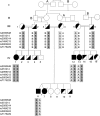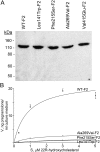Varied clinical presentations of seven patients with mutations in CYP11A1 encoding the cholesterol side-chain cleavage enzyme, P450scc
- PMID: 23337730
- PMCID: PMC3565115
- DOI: 10.1210/jc.2012-2828
Varied clinical presentations of seven patients with mutations in CYP11A1 encoding the cholesterol side-chain cleavage enzyme, P450scc
Erratum in
- J Clin Endocrinol Metab. 2013 Oct;98(10):4213. Pavari, Ruti [corrected to Parvari, Ruti]
Abstract
Context: The cholesterol side-chain cleavage enzyme P450scc, encoded by CYP11A1, converts cholesterol to pregnenolone to initiate steroidogenesis. P450scc deficiency can disrupt adrenal and gonadal steroidogenesis, resembling congenital lipoid adrenal hyperplasia clinically and hormonally; only 12 such patients have been reported previously.
Objective: We sought to expand clinical and genetic experience with P450scc deficiency.
Patients and methods: We sequenced candidate genes in 7 children with adrenal insufficiency who lacked disordered sexual development. P450scc missense mutations were recreated in the F2 vector, which expresses the fusion protein P450scc-Ferredoxin Reductase-Ferredoxin. COS-1 cells were transfected, production of pregnenolone was assayed, and apparent kinetic parameters were calculated. Previously described P450scc mutants were assayed in parallel.
Results: Four of five Bedouin children in one kindred were compound heterozygotes for mutations c.694C>T (Arg232Stop) and c.644T>C (Phe215Ser). Single-nucleotide polymorphism analysis confirmed segregation of these mutations. The fifth kindred member and another Bedouin patient presented in infancy and were homozygous for Arg232Stop. A patient from Fiji presenting in infancy was homozygous for c.358T>C (Arg120Stop). All mutations are novel. As assayed in the F2 fusion protein, P450scc Phe215Ser retained 2.5% of wild-type activity; previously described mutants Leu141Trp and Ala269Val had 2.6% and 12% of wild-type activity, respectively, and Val415Glu and c.835delA lacked detectable activity.
Conclusions: Although P450scc is required to produce placental progesterone required to maintain pregnancy, severe mutations in P450scc are compatible with term gestation; milder P450scc mutations may present later without disordered sexual development. Enlarged adrenals usually distinguish steroidogenic acute regulatory protein deficiency from P450scc deficiency, but only DNA sequencing is definitive.
Figures



References
-
- Miller WL. StAR search: what we know about how the steroidogenic acute regulatory protein mediates mitochondrial cholesterol import. Mol Endocrinol. 2007;21:589–601 - PubMed
-
- Bose HS, Sugawara T, Strauss JF, 3rd, Miller WL. The pathophysiology and genetics of congenital lipoid adrenal hyperplasia. N Engl J Med. 1996;335:1870–1878 - PubMed
-
- Lin D, Sugawara T, Strauss JF, 3rd, et al. Role of steroidogenic acute regulatory protein in adrenal and gonadal steroidogenesis. Science. 1995;267:1828–1831 - PubMed
Publication types
MeSH terms
Substances
Grants and funding
LinkOut - more resources
Full Text Sources
Other Literature Sources
Research Materials
Miscellaneous

